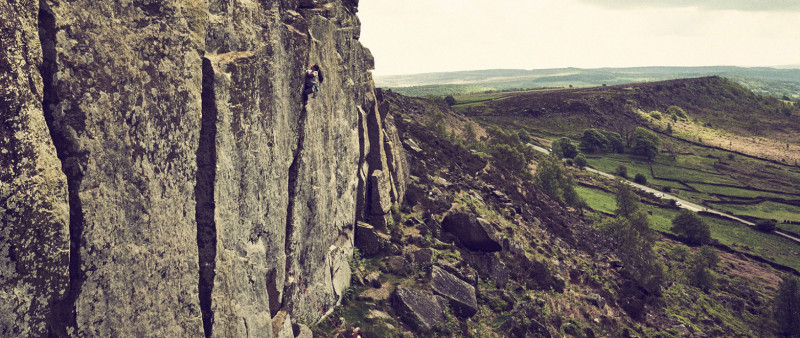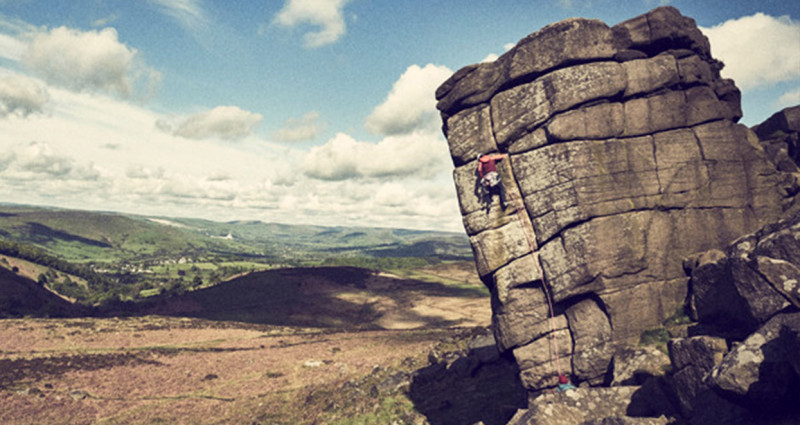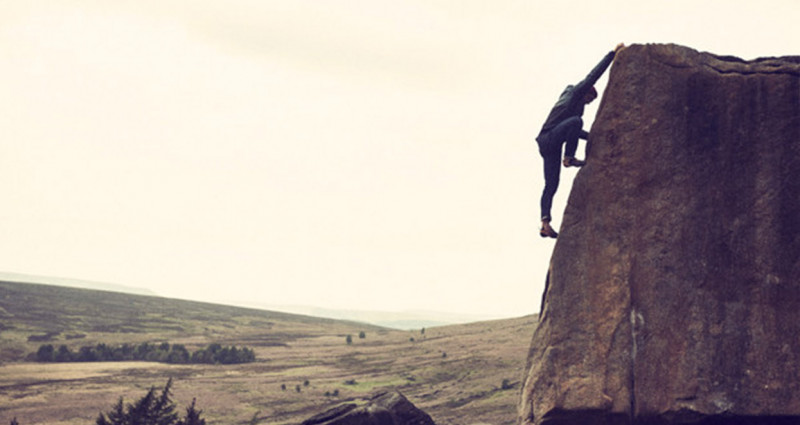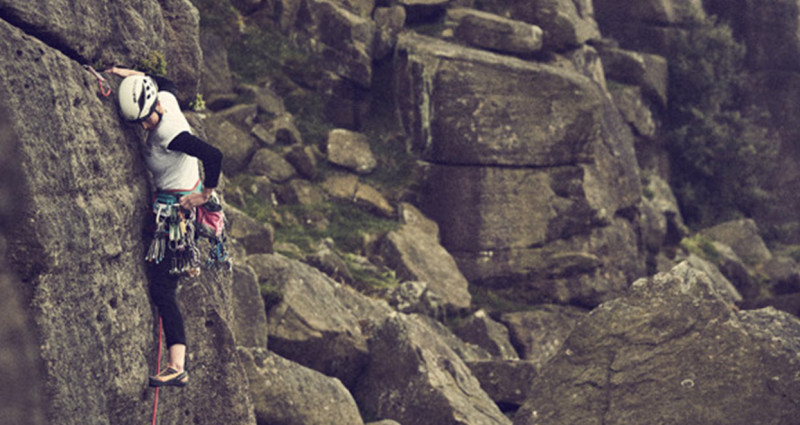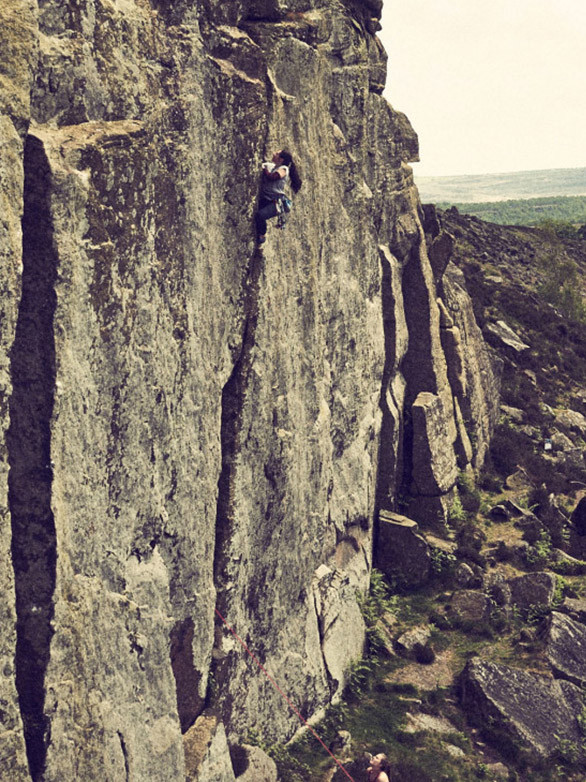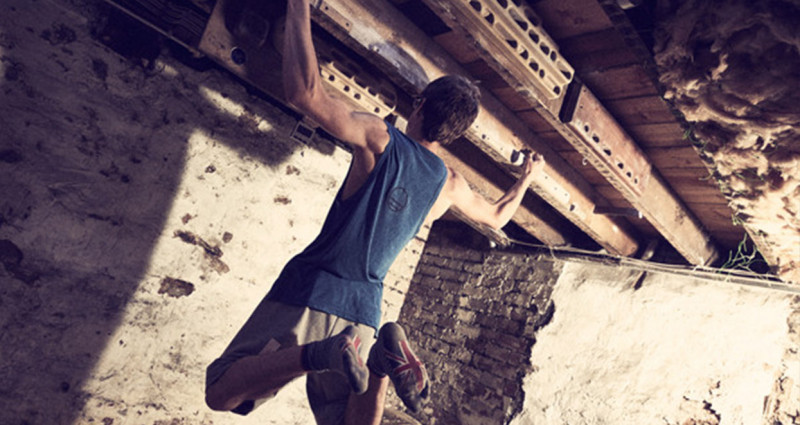Eastern Grit - Diario Di Viaggio
Naomi Buys, ambasciatrice Wild Country, ci porta in vacanza sull'Eastern Grit del Peak District in Gran Bretagna, in cerca di una "roccia permanentemente pulita e incontaminata".
Suggerimenti di viaggi e vacanze
È un FATTO universalmente riconosciuto che l'arenaria è la roccia migliore del mondo per le arrampicate.
La nostra meta locale di arenaria è l'area del Lancashire / Yorkshire che, ovviamente, ha le linee migliori (ehm....). Purtroppo, queste sono in gran parte rivolte a nord, così, dopo un'ondata di maltempo, questi ostili orrori fitti di verde non sono per i palati delicati. Se vuoi trascorrere una giornata divertente su roccia permanentemente pulita e incontaminata, il Peak District è la tua mecca.
Il diario - Trovare il paradiso
Mi avventurai sui labbri dell'Eastern per la prima volta a metà degli anni '90, con mio cugino Kieran. Eravamo due adolescenti inesperti ma pieni di entusiasmo, armati di un rack rabberciato alla meglio, una spelacchiata corda singola da 10 mm, 1 sacco a pelo e un miscuglio di spuntini, tra cui gelatina cruda e yogurt scaduti. A quei tempi facevamo autostop ovunque. Il Peak District è un ottimo posto per questo: tutti sembrano essere amanti della natura e gli autisti non battono ciglio davanti a scalatori squattrinati che elemosinano passaggi.
A Stanage eravamo come bambini in un negozio di caramelle, anche se un po' sopraffatti dalla scelta. Per cominciare, scegliemmo le linee più brevi e meno minacciose. Mi sentivo così gasata! Come sulla traversata a mano della Fina (HVS 5b), quando scelsi di continuare a scalare, invece di fare una pausa per ancorare gli attrezzi... Presto pensammo di essere invincibili. Malgrado alcune terribili nottate (lottando per il sacco a pelo) e cibo ridicolmente inadeguato, ci muovevamo lungo i gradi. Non avevamo una guida, ma sfogliavamo la copia dell'Ostello della Gioventù di “On Peak Rock” tutte le notti, per pianificare le sfide del giorno successivo. A volte facevamo il passo più lungo della gamba: ricordo come fummo puniti da Old Friends (E4), molto più ardua e paurosa di quanto immaginassi, e che non eravamo così in gamba come pensavamo!
Nondimeno, eravamo ormai travolti dalla passione. Nel corso degli anni, sono tornata diverse volte su questo paradiso di roccia. Una delle esperienze più memorabili è stata una giornata magica a Curbar e Froggatt. Nel giro di un paio d'ore, avevo collezionato 40 punti E in solitaria a vista con le seguenti, incredibili vie: Don’t Slip Now E5, Hairless Heart E5, Artless E5, Downhill Racer E4, Narcissus E6, Oedipus Ring Your Mother E4, Heartless Hare E5 e Hairy Heart E6. Il giorno precedente ero molto frustrata, perché non ero riuscita a fare le vie sportive di calcare. Avevo bisogno di terapia mentale e il movimento puro e genuino su quelle ardite, splendide placche aveva riacceso il mio amore per l'arrampicata.
Per me, l'arenaria del Peak significa giocare, sia provando una trad facile, facendo sul serio con l'headpoint, o godendosi un'escursione di bouldering, la roccia sembra creata e scolpita per divertirci, un piacere che si rinnova sempre per me.
Beta - Vie imperdibili
Arenaria pulita e compatta: c'è un'ampia varietà di stili, da ardite solitarie a fessure, placche e strapiombi ben protetti. Queste falesie sono meritatamente popolari. Potresti non trovarci la solitudine, ma avrai vie accessibile e trafficate con scalate fantastiche.
Warm Up - Non lasciarti ingannare Quasi tutte le falesie hanno una buona selezione di vie o boulder facili tra cui scegliere. Controlla le voci del registro UKC per avere un'idea di quali arrampicate siano ragionevoli per il grado e quali siano invece delle “sandbag" ingannevoli, se vuoi evitare brutte sorprese. Classici problemi di boulder
Stanage: Crescent Arete (V2), Not To Be Taken Away (V4), Green Traverse (V6), Deliverance (V8+) e Brad Pit (V9).
Curbar: Trackside (V6), Gorilla Warfare (V6) e Walk On By (V10).
Burbage: The Nose (V6), West Side Story (V9), Banana Finger (V2), Remergence (V4), Blind Date (V8+), The Terrace (V9) e Voyager (V13).
Vie imperdibili
Fessure: The File (VS) a Higgar, che premia lo specialista di incastri, Peapod (HVS) a Curbar, più che altro, una lotta con le fessure offwidth.
Arrampicate strapiombanti: Flying Buttress Direct (HVS) a Stanage: assicurati di avere un amico vicino, pronto con la fotocamera! The Rasp (E2) a Higgar è un'altra arrampicata ripida che sembra facile a chi è forte.
Vie ardite e lastroidi: 3 Pebble Slab a Froggatt è un rito di passaggio e poi potrai partecipare all'eterno dibattito in corso (è una HVS, o una E1?).
Per i forti e gli intrepidi
Stimola l'appetito con Archangel (E3) a Stanage, un meraviglioso spigolo ardito che premia l'approccio sicuro.
Troppo facile? Spostati su Ulysses (E5), poi Master's Edge (E7), entrambi a Millstone. Con London Wall (E5), un esercizio perfetto come “scrocchiadita”.
Preferisci le fessure offwidth? Prova la Goliath (E4) a Burbage South. E, se ancora non basta, prova la Strapadictomy (E5) a Froggatt e la End of the Affair (E8) a Curbar, che hanno entrambe fatto bella mostra di sé su copertine di riviste per le loro linee esteticamente piacevoli, oltre a evocare la sensazione di “cuore in gola”.
Gear
Generally, you won’t find a route longer than 20 – 25m, most are much shorter. A normal rack of wires and friends with 10 to 12 quickdraws will usually suffice. Some routes benefit from double ropes, others you can manage with a single, especially if you have a few slings to extend runners. There are mostly well-trodden descent paths to get you back to the bottom of your route – take some flip-flops for the second to bring up if you want to avoid getting gritty dirt embedded in your rock shoes. Landings tend to be mostly quite flat and friendly, but a pad is always a good idea.
Guidebooks
The BMC has produced some excellent definitive guides, which include detailed information about the routes and boulders at each specific area. For a more general overview, Rockfax Eastern Edges guide covers all the classic routes and their Peak Bouldering guide is extensive. The Vertebrate Peak District Bouldering Guide is really good, with the benefit of local knowledge and awesome photos.
Seasons - What To Expect
Summer can be too warm for climbing ‘hard grit’, but will be perfect for enjoying the lower grade classics. Autumn through Spring offers the best conditions (when it isn’t raining!). Most of the crags in the Eastern grit area face the sun at least for part of the day, and many of the buttresses are quick-drying, especially the edges on open moorland. Mid-winter can sometimes turn the crags into a ‘snow-balling’ playground, giving climbers the opportunity to boulder out some of the more necky lines in relative safety.
Come arrivarci
Si tratta di falesie popolari e il parcheggio è relativamente limitato presso molte di esse; se possibile, condividi il trasporto. I mezzi pubblici sono una buona opzione per falesie come Burbage South (i bus regolari tra Sheffield e Hathersage fermano alla Fox House). Un tempo c'era un servizio di bus per scalatori che attraversava un circuito per le zone principali di arrampicata, ma purtroppo era poco usato e non vitale. Oggi arrivare a Stanage con i mezzi pubblici è un po' una seccatura e una lunga camminata, a meno che tu non abbia successo come autostoppista. Ci sono servizi regolari di bus e treni per Hathersage e Grindleford.
Dritta insider: dove mangiare, bere, dormire
Mangiare e bere
Ci sono alcuni simpatici caffè a Hathersage, che offrono dalle colazioni all'inglese a pranzi salutari speciali.
Outside Café è ospitale con gli scalatori e ha il vantaggio di disporre di un negozio ben fornito.
Little John a Hathersage serve cibo sostanzioso a prezzi ragionevoli.
Fox House presso il Chequers Inn offre cibo un tantino più raffinato, se preferisci. Ci sono anche tanti fantastici locali dove mangiare a Sheffield, se cerchi un po' di varietà internazionale.
Dormire
Campeggio
C'è un campeggio vicino a Hathersage (North Lees) e alcuni altri disseminati per tutto il Peak. Il campeggio libero non è una buona idea; il ranger probabilmente ti chiederà di andartene. Ci sono spiazzi per parcheggiare un furgone, ma sta' attento: molti di questi non permettono di parcheggiare durante la notte.
Sistemazioni
È possibile sistemarsi a prezzi ragionevoli al Little John, Fox House, Norfolk Arms a Ringinglow e presso alcuni hotel: cerca su laterooms.com per gli affari migliori. I cottage vacanze sono anche numerosi, se pianifichi un soggiorno più lungo.
Suggerimenti kit Eastern Grit

1 ISLAND, 2 MONKS AND UNTOUCHED GRANITE
“Why did James and I pick a small dot on the other side of the planet?”
Because Yuji told us about it. The last time Yuji proposed us a trip, we ended up in Kinabalu, the now oh so famous mountain where untouched granite will overwhelm the climber. The Real Rock tour has thrown Kinabalu into fame, but 5 years ago, when we went there, no climber could even put it on the climbing
Kinkasan is a small island not far from Fukushima, on the north east side of Japan. It has 26km circumference and is inhabited by two monks. From Tokyo it is a six hour journey. Yuji didn’t say that much more: Kinkasan’s coast is covered with granite cliffs, and there is a Shinto shrine on it. Yuji mentioned as well the damages made by the tsunami…
We began our journey with next to no expectations about the climbing, and a big question mark for the rest. 3 days in the trip and I know exactly why we came: for Japan.
2 years ago we spent a week in this unique country and both James and I knew that we had to come back one day: how could I compare it? Well, the first time you taste wine, you have heard a lot about it. But you smell, and you only smell the alcohol, you taste and you can’t put words on it because wine is subtle, complicated and requests an education. You have to go back to it, learn to enjoy, differentiate and remember. Japan is maybe a little bit like wine.
There is this astonishing mix of modernity (the Japanese toilets and their multi jets, music and self cleaning options give you an idea of the immensity of your difference) and spirituality, respect, focus.
We arrived at Base Camp, the gym that Yuji opened 5 years ago in Tokyo, and I oscillate between marvel and shame. I am a pro climber, and most of the boulders are too hard for me, the Japanese climbers around me seem to evolve so effortlessly, like flying cats on the wall. But then you realise: the world championship have just finished in Paris and in the bouldering competition, 3 of the 6 medals are not only Japanese, but from Tokyo, from Base Camp. Yuji and his company helps the athletes become professional and they often climb together. Shall I repeat that? Half of the world’s medals come from one gym! Surely there is no wonder that Yuji owns that gym… But that is only just the very top of the iceberg, because behind this 3 medals, there are a lot of other athletes with an incredible level. I have never seen so many good, extremely good boulderers in one place. And I am a former competition climber, trust me, I know what I am talking about.
“Why are they so good?”
The answer is surely complicated but here are a few elements: climbing has become very trendy in Japan, with over a 100 gyms in Tokyo. The Japanese body type is perfect for climbing; light, powerful and explosive muscles. The Japanese constant pursuit of perfection pushes the athletes to train hard, just like everyone around them simply accomplished every task with perfection.
It was dry for the crossing, and after unpacking our bags at the shrine we bouldered on a nearby beach for 1 hour before the rain came. With so much rock to see and so little time, we hiked out anyway along the coast to search out potential lines. The rain became heavier, we became wetter, and after 4 soggy hours we returned to the shrine, hopes high but spirits low. We’d been preparing this trip since September 2015, putting the team together, finding funding from sponsors, organizing the local logistics, yet it would all be in vain if the weather didn’t brighten up.
A morning of rain gave us the excuse to sit down and record some interviews, though truthfully we had little to say as we’d done little climbing. Toru, ever the silent optimist finally dragged me out to the closest boulder spot during a break between two showers, and we were surprisingly able to climb! Toru lived up to his reputation of boldness and brilliance, making the first ascents of two of Kinkasan’s boldest and hardest problems. Finally things were looking up. The forecast was good for the following days, and group psyche could not have been higher. We began to plan our upcoming adventure and our first trip to the other side of the island – the area with the highest concentration of rock, and the biggest cliffs, but had to cut them short as bad news broke.
With my thirst for climbing temporarily quenched, we left the island in limbo, happy, yet sad, but knowing we’d be back in less than 24 hours. We passed the day visiting some of the worst tsunami affected towns in an effort to better understand what hardships the local people had to live through, and how they are moving forwards towards the future. It is one thing to watch the news from the comfort of your lounge back home, it is another thing entirely to see it first hand, and speak to the people who have lost everything - houses, possessions, loved ones!
Suddenly our troubles with the rain seemed embarrassingly small, and we remembered why we were actually here in the first place.
Our personal climbing desires must come second to the larger goal of showing this place to the world. Rain or shine, we have to get out there. Hike around, document the potential, and if in the end we are lucky, open up some new routes.

